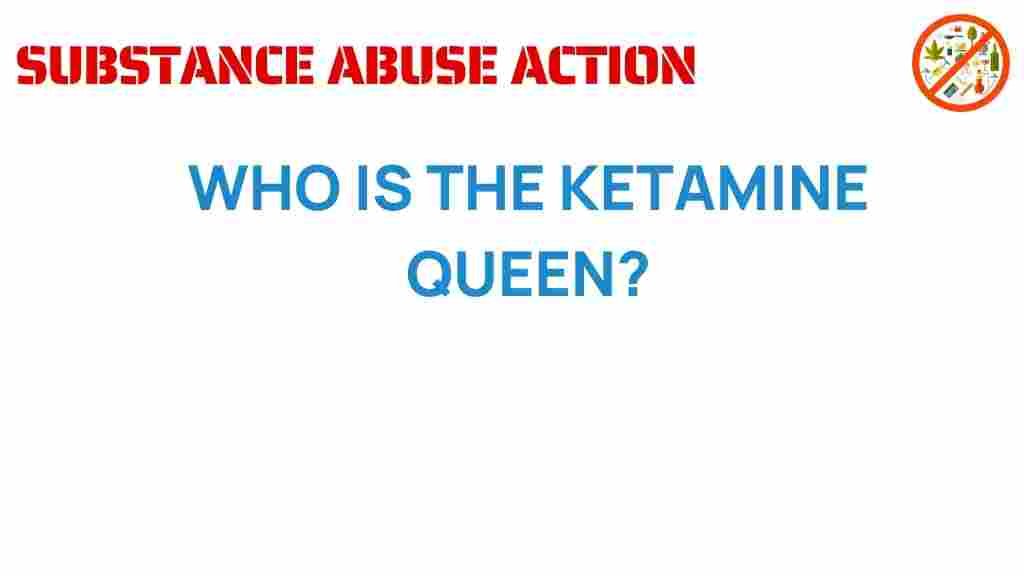Unveiling the Mystery: Who Is the Ketamine Queen?
The conversation around mental health is evolving, and at the forefront of this discussion is an innovative treatment that has garnered significant attention: ketamine. In recent years, ketamine therapy has emerged as a beacon of hope for many individuals grappling with mental health challenges, particularly those resistant to traditional treatments. But who is the “Ketamine Queen,” and what role does she play in this groundbreaking field? In this article, we will explore the intersection of ketamine, mental health, and innovative therapeutic practices, all while addressing the stigma that often surrounds these discussions.
The Rise of Ketamine in Mental Health Treatment
For a long time, ketamine was primarily known as an anesthetic used in surgical settings. However, its potential for treating mental health conditions has sparked interest among psychiatrists and researchers alike. The compound has shown promise in addressing conditions such as:
- Depression
- Anxiety disorders
- Post-traumatic stress disorder (PTSD)
- Obsessive-compulsive disorder (OCD)
- Chronic pain syndromes associated with mental health
Ketamine works differently than traditional antidepressants, often providing rapid relief from symptoms. This unique mechanism is part of what makes ketamine a game-changer in the realm of mental health treatment, pushing the boundaries of psychiatric care.
Understanding the Ketamine Queen
The term “Ketamine Queen” typically refers to a leading figure in the field of ketamine therapy—often a psychiatrist or researcher who has made significant contributions to the understanding and application of ketamine in mental health treatment. This individual exemplifies the intersection of neuroscience, innovation, and compassionate care.
Many Ketamine Queens operate clinics that specialize in administering ketamine infusions or nasal sprays, guiding patients through the process of treatment, and monitoring their progress. Their work challenges the stigma surrounding mental health treatments and highlights the importance of innovative therapies in the healing process.
The Healing Process of Ketamine Therapy
So, how does ketamine therapy work? Here’s a step-by-step overview of the treatment process:
Step 1: Initial Consultation
The journey begins with an initial consultation with a healthcare provider specializing in ketamine therapy. During this appointment, the provider will:
- Discuss the patient’s mental health history
- Evaluate previous treatments
- Determine if ketamine therapy is appropriate for the patient
Step 2: Treatment Plan Development
If ketamine is deemed suitable, the provider will create a personalized treatment plan that may include:
- Dosage and frequency of ketamine administration
- Type of administration (infusion or nasal spray)
- Additional therapies or support services
Step 3: Administration of Ketamine
Ketamine can be administered in several ways, but the most common methods include:
- Intravenous (IV) infusion
- Nasal spray
The administration typically occurs in a controlled, comfortable setting, often with the patient monitored by healthcare professionals.
Step 4: Monitoring and Follow-Up
After treatment, patients are monitored for any immediate side effects and to assess the therapy’s effectiveness. Follow-up appointments are crucial for:
- Adjusting dosages if necessary
- Evaluating long-term progress
- Incorporating additional therapeutic modalities
Addressing the Stigma of Ketamine Therapy
Despite its potential, ketamine therapy is often met with skepticism and stigma. Some common misconceptions include:
- “It’s just a party drug.” While ketamine has recreational uses, its application in mental health is grounded in rigorous research and clinical practices.
- “It’s not a legitimate treatment.” Ketamine therapy is recognized by many in the psychiatric community as a valid treatment option for certain mental health conditions.
Addressing these stigmas is essential for encouraging individuals to seek out innovative treatment options. The Ketamine Queen and her colleagues play a crucial role in educating the public and dispelling myths about ketamine therapy.
Neuroscience Behind Ketamine’s Effectiveness
The scientific understanding of how ketamine affects the brain is still evolving, but research suggests several key mechanisms:
- NMDA Receptor Antagonism: Ketamine blocks the NMDA receptor, leading to an increase in glutamate levels, which may promote synaptic plasticity.
- Increased Brain-Derived Neurotrophic Factor (BDNF): Ketamine may enhance BDNF, a protein linked to neuroplasticity and healing.
- Rapid Antidepressant Effects: Unlike traditional antidepressants that may take weeks to work, ketamine can provide relief within hours.
Understanding these mechanisms is critical for both clinicians and patients as they navigate the complexities of mental health treatment.
Troubleshooting Common Concerns
As with any medical treatment, patients may have concerns or experience side effects. Here are some common issues and their solutions:
Concern 1: Side Effects
While many patients tolerate ketamine well, some may experience:
- Dizziness
- Nausea
- Altered perception
Solution: It’s important to discuss any side effects with your provider, who can adjust dosages or provide additional support.
Concern 2: Efficacy Questions
Some patients might wonder if ketamine will work for them, especially if they’ve tried other treatments without success.
Solution: Open communication with your healthcare provider about your treatment history and expectations is key. They can help tailor the approach to maximize efficacy.
Concern 3: Financial Considerations
Ketamine therapy can be costly, and insurance coverage may vary.
Solution: Many clinics offer financing options or payment plans. It’s advisable to inquire about costs upfront and explore possible financial assistance.
Conclusion: The Future of Ketamine Therapy
The emergence of ketamine therapy represents a significant innovation in the field of psychiatry and mental health treatment. Through the work of leaders in this field, often referred to as the Ketamine Queens, patients are finding new pathways to healing. As the stigma around mental health continues to decrease, more individuals can explore effective treatments like ketamine.
As research progresses and more practitioners adopt this innovative approach, ketamine therapy holds the potential to revolutionize the way we understand and treat mental health disorders. If you are interested in learning more about ketamine therapy and its applications, consider reaching out to a local provider or visiting additional resources for more information. Together, we can work towards a future where mental health treatment is accessible, effective, and free of stigma.
This article is in the category Treatment and created by SubstanceAbuseAction Team
